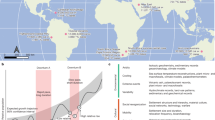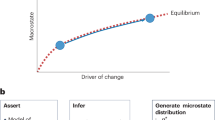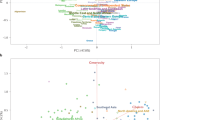Abstract
Challenges due to the rapid urbanization of the world — especially in emerging countries — range from an increasing dependence on energy to air pollution, socio-spatial inequalities and environmental and sustainability issues. Modelling the structure and evolution of cities is therefore critical because policy makers need robust theories and new paradigms for mitigating these problems. Fortunately, the increased data available about urban systems opens the possibility of constructing a quantitative ‘science of cities’, with the aim of identifying and modelling essential phenomena. Statistical physics plays a major role in this effort by bringing tools and concepts able to bridge theory and empirical results. This Perspective illustrates this point by focusing on fundamental objects in cities: the distribution of the urban population; segregation phenomena and spin-like models; the polycentric transition of the activity organization; energy considerations about mobility and models inspired by gravity and radiation concepts; CO2 emitted by transport; and finally, scaling that describes how various socio-economical and infrastructures evolve when cities grow.
This is a preview of subscription content, access via your institution
Access options
Access Nature and 54 other Nature Portfolio journals
Get Nature+, our best-value online-access subscription
$29.99 / 30 days
cancel any time
Subscribe to this journal
Receive 12 digital issues and online access to articles
$99.00 per year
only $8.25 per issue
Buy this article
- Purchase on Springer Link
- Instant access to full article PDF
Prices may be subject to local taxes which are calculated during checkout




Similar content being viewed by others
References
United Nations. World Urbanization Prospects. https://esa.un.org/unpd/wup/ (2018).
Chorley, R. & Haggett, P. Models in geography (1967).
Fujita, M., Krugman, P. & Venables, A. The Spatial Economy: Cities, Regions, and International Trade (MIT Press, Cambridge, 2001).
Batty, M. The New Science of Cities (MIT Press, Cambridge, 2013).
Barthelemy, M. The Structure and Dynamics of Cities (Cambridge University Press, Cambridge, 2016).
Kivelson, S. & Kivelson, S. Understanding complexity. Nat. Phys. 14, 426 (2018).
Newman, P. & Kenworthy, J. Gasoline consumption and cities: a comparison of US cities with a global survey. J. Am. Plan. Assoc. 55, 24–37 (1989).
Vespignani, A. Predicting the behavior of techno-social systems. Science 325, 425–428 (2009).
Castellano, C., Fortunato, S. & Loreto, V. Statistical physics of social dynamics. Rev. Mod. Phys. 81, 591 (2009).
Dadashpoor, H. & Yousefi, Z. Centralization or decentralization? A review on the effects of information and communication technology on urban spatial structure. Cities 78, 194–205 (2018).
Blondel, V., Decuyper, A. & Krings, G. A survey of results on mobile phone datasets analysis. EPJ Data Sci. 4, 10 (2015).
Barbosa, H., Barthelemy, M., Ghoshal, G., James, C., Lenormand, M., Louail, T., Menezes, R., Ramasco, J., Simini, F. & Tomasini, M. Human mobility: models and applications. Phys. Rep. 734, 1–74 (2018).
Zipf, G. Human Behavior and the Principle of Least Effort: An Introduction to Human Ecology (Addison-Wesley, Cambridge, MA, 1949).
Batty, M. Rank clocks. Nature 444, 592 (2006).
Malevergne, Y., Pisarenko, V. & Sornette, D. Testing the Pareto against the lognormal distributions with the uniformly most powerful unbiased test applied to the distribution of cities. Phys. Rev. E 83, 036111 (2011).
Soo, K. Zipf’s Law for cities: a cross-country investigation. Reg. Sci. Urban Econ. 35, 239–263 (2005).
Cristelli, M. & Batty, M. P. L. There is more than a power law in Zipf. Sci. Rep. 2, 812 (2012).
Gibrat, R. Les inégalités économiques: applications: aux inégalités des richesses, à la concentration des entreprises, aux populations des villes, aux statistiques des familles, etc: d’une loi nouvelle: la loi de l’effet proportionnel (Librairie du Recueil Sirey, 1931).
Marsili, M. & Zhang, Y. Interacting individuals leading to Zipf’s law. Phys. Rev. Lett. 80, 2741 (1998).
Gabaix, X. Zipf’s law for cities: an explanation. Quart. J. Econ. 114, 739–767 (1999).
Levy, M. & Solomon, S. Power laws are logarithmic Boltzmann laws. Int. J. Mod. Phys. C 7, 595–601 (1996).
Sornette, D. & Cont, R. Convergent multiplicative processes repelled from zero: power laws and truncated power laws. J. Phys. I 7, 431–444 (1997).
Bouchaud, J.-P. & Mézard, M. Wealth condensation in a simple model of economy. Physica A 282, 536–545 (2000).
De Nadai, M., Staiano, J., Larcher, R., Sebe, N., Quercia, D. & Lepri, B. The death and life of great Italian cities: a mobile phone data perspective. in 25th International World Wide Web Conferences (2016).
Sulis, P., Manley, E., Zhong, C. & Batty, M. Using mobility data as proxy for measuring urban vitality. J. Spat. Inf. Sci. 16, 137–162 (2018).
Jacobs, J. The Death and Life of Great American Cities (Vintage, New York, NY, 1961).
D’Silva, K., Noulas, A., Musolesi, M., Mascolo, C. & Sklar, M. If I build it, will they come?: Predicting new venue visitation patterns through mobility data. in Proceedings of the 25th ACM SIGSPATIAL International Conference on Advances in Geographic Information Systems (2017).
Bouchaud, J.-P. Crises and collective socio-economic phenomena: simple models and challenges. J. Stat. Phys. 151, 567–606 (2013).
Venerandi, A., Zanella, M., Romice, O., Dibble, J. & Porta, S. Form and urban change–An urban morphometric study of five gentrified neighbourhoods in London. Environment and Planning B: Urban Analytics and City. Science 44, 1056–1076 (2017).
Schelling, T. Dynamic models of segregation. J. Math. Sociol. 1, 143–186 (1971).
Grauwin, S., Bertin, E., Lemoy, R. & Jenson, P. Competition between collective and individual dynamics. Proc. Natl Acad. Sci. USA 106, 20622–20626 (2009).
Gauvin, L., Vannimenus, J. & Nadal, J.-P. Phase diagram of a Schelling segregation model. Eur. Phys. J. B 70, 293–304 (2009).
Dall’Asta, L., Castellano, C. & Marsili, M. Statistical physics of the Schelling model of segregation. J. Stat. Mech.: Theory Exp. 7, L07002 (2008).
Jensen, P., Matreux, T., Cambe, J., Larralde, H. & Bertin, E. Giant catalytic effect of altruists in Schelling’s segregation model. Phys. Rev. Lett. 120, 208301 (2018).
Vinković, D. & Kirman, A. A physical analogue of the Schelling model. Proc. Natl. Acad. Sci. USA. 103, 19261–19265 (2006).
Bertaud, A. & Malpezzi, S. The spatial distribution of population in 48 world cities: implications for economies in transition. in World Bank Report (2003).
Anas, A., Arnott, R. & Small, K. Urban spatial structure. J. Econ. Lit. 36, 1426–1464 (1998).
Ratti, C., Frenchman, D., Pulselli, R. & Williams, S. Mobile landscapes: using location data from cell phones for urban analysis. Environ. Plan. B 33, 727–748 (2006).
Louail, T. et al. From mobile phone data to the spatial structure of cities. Sci. Rep. 4, 5276 (2014).
Louail, T. et al. Uncovering the spatial structure of mobility networks. Nat. Commun. 6, 6007 (2015).
Louf, R. & Barthelemy, M. Modeling the polycentric transition of cities. Phys. Rev. Lett. 111, 198702 (2013).
Samaniego, H. & Moses, M. Cities as organisms: allometric scaling of urban road networks. J. Transp. Land Use 1, 21–39 (2008).
Zhong, C. et al. Revealing centrality in the spatial structure of cities from human activity patterns. Urban Stud. 54, 437–455 (2017).
Zhang, X., Xu, Y., Tu, W. & Ratti, C. Do different datasets tell the same story about urban mobility — A comparative study of public transit and taxi usage. J. Transp. Geogr. 70, 78–90 (2018).
Krugman, P. The Self-Organizing Economy (CIMMYT, 1996).
Fujita, M. & Ogawa, H. Multiple equilibria and structural transition of non-monocentric urban configurations. Reg. Sci. Urban Econ. 12, 161–196 (1982).
Louf, R. & Barthelemy, M. How congestion shapes cities: from mobility patterns to scaling. Sci. Rep. 4, 5561 (2014).
Wigner, E. Characteristic vectors of bordered matrices with infinite dimensions. Ann. Math. 62, 548–564 (1955).
Branston, D. Link capacity functions: a review. Transp. Res. 10, 223–236 (1976).
Huntsinger, L. & Rouphail, N. Bottleneck and queuing analysis: calibrating volume–delay functions of travel demand models. Transp. Res. Rec. 2255, 117–124 (2011).
Varga, L., Kovács, A., Tóth, G., Papp, I. & Néda, Z. Further we travel the faster we go. PloS One 11, e0148913 (2016).
Gallotti, R., Bazzani, A., Rambaldi, S. & Barthelemy, M. A stochastic model of randomly accelerated walkers for human mobility. Nat. Commun. 7, 12600 (2016).
Zahavi, Y. Traveltime budgets and mobility in urban areas (1974).
Marchetti, C. Anthropological invariants in travel behavior. Technol. Forecast. Soc. change 47, 75–88 (1994).
Mokhtarian, P. & Chen, C. TTB or not TTB, that is the question: a review and analysis of the empirical literature on travel time (and money) budgets. Transp. Res. Part A 38, 643–675 (2004).
Levinson, D. & Wu, Y. The rational locator reexamined: Are travel times still stable?. Transportation 32, 187–202 (2005).
Zhu, S. & Levinson, D. Do people use the shortest path? An empirical test of Wardrop’s first principle. PLoS One 10, e0134322 (2015).
Tang, W. & Levinson, D. Deviation between actual and shortest travel time paths for commuters. J. Transp. Eng. Part A 144, 04018042 (2018).
Lima, A., Stanojevic, R., Papagiannaki, D., Rodriguez, P. & González, M. Understanding individual routing behaviour. J. R. Soc. Interface 13, 20160021 (2016).
Noulas, A., Scellato, S., Lambiotte, R., Pontil, M. & Mascolo, C. A tale of many cities: universal patterns in human urban mobility. PloS One 7, e37027 (2012).
Çolak, S., Lima, A. & González, M. Understanding congested travel in urban areas. Nat. Commun. 7, 10793 (2016).
Solé-Ribalta, A., Gómez, S. & Arenas, A. Decongestion of urban areas with hotspot pricing. Netw. Spat. Econ. 18, 33–50 (2018).
Kolbl, R. & Helbing, D. Energy laws in human travel behaviour. New J. Phys. 5, 48 (2003).
Zipf, G. The P 1 P 2/D hypothesis: on the intercity movement of persons. Am. Sociol. Rev. 11, 677–686 (1946).
Erlander, S. & Stewart, N. The Gravity Model in Transportation Analysis: Theory and Extensions (Vsp, 1990).
Lenormand, M., Huet, S., Gargiulo, F. & Deffuant, G. A universal model of commuting networks. PloS One 7, e45985 (2012).
Simini, F., González, M., Maritan, A. & Barabási, A. A universal model for mobility and migration patterns. Nature 484, 96 (2012).
Wilson, A. Complex Spatial Systems: The Modelling Foundations of Urban and Regional Analysis (Routledge, 2014).
Varga, L., Tóth, G. & Néda, Z. Commuting patterns: the flow and jump model and supporting data. EPJ Data Sci. 7, 37 (2018).
Lenormand, M., Bassolas, A. & Ramasco, J. Systematic comparison of trip distribution laws and models. J. Transp. Geogr. 51, 158–169 (2016).
Carra, G., Mulalic, I., Fosgerau, M. & Barthelemy, M. Modelling the relation between income and commuting distance. J. R. Soc. Interface 13, 20160306 (2016).
Yang, X., Belyi, A., Bojic, I. & Ratti, C. Human mobility and socioeconomic status: analysis of Singapore and Boston. Comput. Environ. Urban Syst. 72, 51–67 (2018).
Pumain, P. Scaling Laws and Urban Systems (Santa Fe Institute, 2004).
Bettencourt, L., Lobo, J. & Youn, H. The hypothesis of urban scaling: formalization, implications and challenges. https://arxiv.org/abs/1301.5919 (2013).
Bettencourt, L., Lobo, J., Helbing, D., Kühnert, C. & West, G. Growth, innovation, scaling, and the pace of life in cities. Proc. Natl Acad. Sci. USA 104, 7301–7306 (2007).
Schläpfer, M. et al. The scaling of human interactions with city size. J. R. Soc. Interface 11, 20130789 (2014).
Bettencourt, L. The origins of scaling in cities. Science 340, 1438–1441 (2013).
Arcaute, E. et al. Constructing cities, deconstructing scaling laws. J. R. Soc. Interface 12, 20140745 (2015).
Leitao, J., Miotto, J., Gerlach, M. & Altmann, E. Is this scaling nonlinear?. R. Soc. Open Sci. 3, 150649 (2016).
Dyson, F. The key to everything. The New York Review of Books, 10 May (2018).
Rozenfeld, H. et al. Laws of population growth. Proc. Natl Acad. Sci. USA 105, 18702–18707 (2008).
Depersin, J. & Barthelemy, M. From global scaling to the dynamics of individual cities. Proc. Natl. Acad. Sci. USA 115, 2317–2322 (2018).
Bouchaud, J.-P., Cugliandolo, L., Kurchan, J. & Mezard, M. in Spin Glasses and Random Fields (ed. Young, A.) (Singapore, World Scientific, 1998).
Thisse, J.-F. The New Science Of Cities by Michael Batty: the opinion of an economist. J. Econ. Lit. 52, 805–819 (2014).
Meirelles, J., Neto, C. R., Ferreira, F. F., Ribeiro, F. L. & Binder, C. Evolution of urban scaling: evidence from Brazil. Preprint at http://arxiv.org/abs/1807.02292 (2018).
Canadell, J., C. P., Le QuéRé, C., Dhakal, S. & Raupach, M. The human perturbation of the carbon cycle (UNESCO-SCOPE-UNEP, Paris, 2009).
Moran, D. et al. Carbon footprints of 13 000 cities. Environ. Res. Lett. 13, 064041 (2018).
Velasco, E. & Roth, M. Cities as net sources of CO2: Review of atmospheric CO2 exchange in urban environments measured by eddy covariance technique. Geogr. Compass 4, 1238–1259 (2010).
Glaeser, E. & Kahn, M. The greenness of cities: carbon dioxide emissions and urban development. J. Urban Econ. 67, 404–418 (2010).
Louf, R. & Barthelemy, M. Scaling: lost in the smog. Environ. Plan. B 41, 767–769 (2014).
Fragkias, M., Lobo, J., Strumsky, D. & Seto, K. Does size matter? Scaling of CO2 emissions and US urban areas. PloS One 8, e64727 (2013).
Oliveira, E., Andrade, J. & Makse, H. Large cities are less green. Sci. Rep. 4, 4235 (2014).
Rybski, D. et al. Cities as nuclei of sustainability? Environment and Planning B: Urban Analytics and City. Science 44, 425–440 (2017).
Carantino, B. & Lafourcade, M. The carbon “carprint” of suburbanization: new evidence from French Cities. CEPR Discussion Papers (2018).
Verbavatz, V. & Barthelemy, M. Critical factors for mitigating car traffic in cities. Preprint at https://arxiv.org/abs/1901.01386 (2019).
Creutzig, F., Baiocchi, G., Bierkandt, R., Pichler, P. & Seto, K. Global typology of urban energy use and potentials for an urbanization mitigation wedge. Proc. Natl. Acad. Sci. USA 112, 6283–6288 (2015).
Levinson, D. & Yerra, B. Self-organization of surface transportation networks. Transp. Sci. 40, 179–188 (2006).
Strano, E., Nicosia, V., Latora, V., Porta, S. & Barthelemy, M. Elementary processes governing the evolution of road networks. Sci. Rep. 2, 296 (2012).
Kivelä, M. et al. Multilayer networks. J. Complex Netw. 2, 203–271 (2014).
Gallotti, R. & Barthelemy, M. Anatomy and efficiency of urban multimodal mobility. Sci. Rep. 4, 6911 (2014).
Sobstyl, J., Emig, T., Qomi, M., Ulm, F. & Pellenq, R. Role of city texture in urban heat islands at nighttime. Phys. Rev. Lett. 120, 108701 (2018).
Bunde, A. & Havlin, S. (eds). Fractals and Disordered Systems (Springer Science & Business Media, 1996).
Batty, M. & Longley, P. Fractal Cities: A Geometry of Form and Function (Academic Press, 1994).
Tannier, C. & Pumain, D. Fractals in urban geography: a theoretical outline and an empirical example. Cybergeo (2005).
Benguigui, L. & Daoud, M. Is the suburban railway system a fractal?. Geogr. Anal. 23, 362 (1991).
Witten, T. & Sander, L. Diffusion-limited aggregation. Phys. Rev. B 27, 5686 (1983).
Makse, H., Havlin, S. & Stanley, H. Modelling urban growth patterns. Nature 377, 608 (1995).
Makse, H., Andrade, J., Batty, M., Havlin, S. & Stanley, H. Modeling urban growth patterns with correlated percolation. Phys. Rev. E 58, 7054 (1998).
Census Bureau. https://www.census.gov/ (2018).
European Commission. https://ec.europa.eu/eurostat/ (2018).
Labs, N. Y. P. L. http://www.nypl.org/collections/labs (2015).
M. Barthelemy. Quanturb data page. https://www.quanturb.com/data.html (2018).
Geohistorical Data Research Group. http://www.geohistoricaldata.org (2018).
Author information
Authors and Affiliations
Corresponding author
Ethics declarations
Competing interests
The author declares no competing interests.
Additional information
Publisher’s noteSpringer Nature remains neutral with regard to jurisdictional claims in published maps and institutional affiliations.
Rights and permissions
About this article
Cite this article
Barthelemy, M. The statistical physics of cities. Nat Rev Phys 1, 406–415 (2019). https://doi.org/10.1038/s42254-019-0054-2
Published:
Issue Date:
DOI: https://doi.org/10.1038/s42254-019-0054-2
This article is cited by
-
Defining a city — delineating urban areas using cell-phone data
Nature Cities (2024)
-
Worldwide scaling of waste generation in urban systems
Nature Cities (2024)
-
The role of complexity for digital twins of cities
Nature Computational Science (2023)
-
The impact of social influence in Australian real estate: market forecasting with a spatial agent-based model
Journal of Economic Interaction and Coordination (2023)
-
Forecasting the evolution of fast-changing transportation networks using machine learning
Nature Communications (2022)



